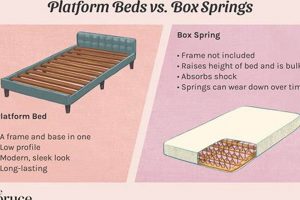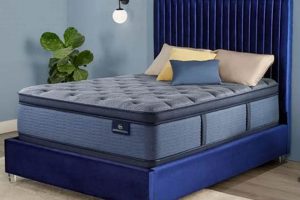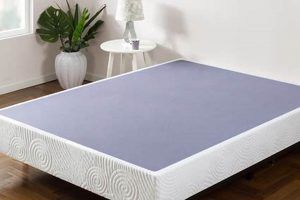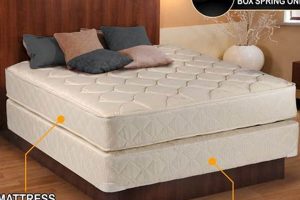A compressed and rolled mattress manufactured by Nectar, delivered directly to the consumer’s door, represents a significant shift in the bedding industry. This product category offers convenience in transportation and setup compared to traditional in-store mattress purchases, streamlining the acquisition process. The product, once unboxed, expands to its full size, ready for use after a designated period.
The rise in popularity of direct-to-consumer mattresses stems from the advantages they offer, including simplified purchasing, reduced overhead costs for manufacturers potentially leading to competitive pricing, and the elimination of traditional retail markups. Historically, mattress buying involved navigating showrooms and dealing with sales personnel. This new approach disrupts that model, providing an alternative focused on online research and home trials.
The following sections will delve into the materials commonly used in these mattresses, examine the various construction methods employed, and explore the considerations related to firmness, support, and temperature regulation for optimal sleep experience. Furthermore, insights into warranty policies and customer reviews will be provided to facilitate informed purchasing decisions.
Optimizing the Nectar Mattress Experience
To maximize the lifespan and benefits of the product, adhere to these guidelines for unpacking, maintenance, and usage.
Tip 1: Unpack Promptly: Upon delivery, remove the compressed mattress from its packaging within 72 hours. Prolonged compression may affect the materials ability to fully expand to its intended dimensions and firmness.
Tip 2: Allow Full Expansion: Following unpacking, allow a minimum of 24-72 hours for the mattress to fully expand. While it will become usable sooner, complete expansion ensures accurate assessment of comfort and support.
Tip 3: Use a Proper Bed Frame: Employ a supportive bed frame or foundation designed for foam mattresses. Slatted frames should have slats no more than a few inches apart to prevent sagging and maintain warranty validity.
Tip 4: Rotate Regularly: Rotate the mattress 180 degrees every 3-6 months. This practice promotes even wear, prevents body impressions, and extends the lifespan of the sleeping surface.
Tip 5: Protect from Moisture: Utilize a waterproof mattress protector to safeguard against spills, stains, and moisture accumulation. Moisture can degrade the foam and compromise its structural integrity.
Tip 6: Maintain Cleanliness: Vacuum the mattress surface periodically to remove dust, allergens, and debris. Adhere to the manufacturer’s cleaning recommendations for spot treatments.
Tip 7: Understand the Trial Period: Familiarize yourself with the manufacturer’s trial period and return policy. This allows adequate time to assess comfort and suitability within the intended sleep environment.
By adhering to these preventative measures and maintenance practices, the user can ensure optimal performance, longevity, and a comfortable sleep experience with a Nectar mattress.
The subsequent sections will elaborate on troubleshooting common issues and maximizing the value offered by the product’s warranty.
1. Convenience
The association between convenience and the compressed mattress delivery system stems from the streamlined acquisition process. This method bypasses traditional retail channels, mitigating the necessity for in-store visits, salesperson interactions, and logistical challenges associated with transporting a full-size mattress. Direct delivery to the consumer’s residence eliminates the need for personal transportation, often requiring specialized vehicles and physical exertion. The compressed packaging facilitates maneuvering the product through doorways and tight spaces within a dwelling, a significant advantage over handling conventional mattresses.
Consider a scenario involving an individual residing in an apartment building with limited elevator access. The delivery of a full-size mattress through conventional means would present considerable obstacles. The compressed mattress, however, can be readily transported and maneuvered within such constrained environments. Furthermore, the unboxing and expansion process is relatively straightforward, demanding minimal technical expertise. The removal of protective layers and the subsequent waiting period for full expansion constitute the primary actions required from the consumer.
In summary, the convenience factor of the “nectar mattress in a box” paradigm resides in its simplification of the purchasing, delivery, and setup procedures. This efficiency addresses logistical challenges inherent in traditional mattress acquisition, offering a more accessible and manageable option for consumers. While material quality, support, and other factors remain critical considerations, the convenience aspect significantly contributes to the overall value proposition of this product category.
2. Materials
The performance characteristics of a “nectar mattress in a box” are intrinsically linked to the materials utilized in its construction. These materials directly influence factors such as comfort, support, durability, and temperature regulation. A mattress employing high-density memory foam, for example, will exhibit a distinct feel and support profile compared to one primarily composed of latex or innerspring coils. The quality and composition of the foam layers determine the degree of contouring to the body, pressure relief, and motion isolation. Lower-quality foams may exhibit premature degradation, leading to sagging and a diminished lifespan, directly impacting the user’s sleep experience.
Furthermore, the cover material plays a crucial role in breathability and moisture management. A cover constructed from breathable fabrics, such as Tencel or cotton, facilitates airflow and reduces heat retention, contributing to a cooler sleep environment. Conversely, synthetic covers with limited breathability can trap heat, leading to discomfort. The specific type of memory foam also matters; gel-infused memory foam is designed to dissipate heat more effectively than traditional memory foam. Real-world examples demonstrate that mattresses with advanced cooling technologies and breathable materials often receive higher customer satisfaction ratings, particularly among individuals who tend to sleep hot. The density and ILD (Indentation Load Deflection) of the foam layers dictate the firmness and support levels, thus impacting spinal alignment and overall comfort.
In conclusion, a thorough understanding of the materials comprising a “nectar mattress in a box” is essential for informed decision-making. The materials employed directly dictate the mattress’s performance, longevity, and suitability for individual sleep preferences and needs. While factors such as price and warranty are important considerations, prioritizing material quality and understanding its impact on the sleep experience remains paramount to achieving optimal satisfaction and long-term value. Challenges arise in accurately assessing material quality based solely on marketing claims; independent reviews and certifications can provide valuable insights in navigating these complexities.
3. Support
Within the context of a compressed mattress delivered in a box, “support” refers to the mattress’s ability to maintain spinal alignment and distribute body weight evenly, minimizing pressure points and preventing discomfort or pain. Inadequate support can result in misalignment, leading to back pain, muscle stiffness, and disrupted sleep. The degree of support offered is directly influenced by the internal construction of the mattress, including the type and density of foam layers, the presence of coil systems (if any), and the overall design. A mattress lacking sufficient support may sag or conform excessively to the body’s contours, failing to maintain the natural curvature of the spine. An example of this is a mattress comprised solely of low-density memory foam, which, while providing initial comfort, may not offer adequate resistance against compression, leading to spinal misalignment over time. The understanding of support is practically significant because it directly impacts the health and quality of sleep. Improper support can negate other potential benefits, such as pressure relief or temperature regulation.
Mattress support characteristics are tailored for various sleeping positions and body types. Side sleepers, for instance, require sufficient contouring to accommodate the shoulders and hips while maintaining spinal alignment. Back sleepers need consistent support across the entire surface to prevent the hips from sinking too deeply. Stomach sleepers often need the firmest support to prevent excessive arching of the lower back. The effectiveness of a “nectar mattress in a box” in providing adequate support can be assessed through independent reviews, product specifications, and, ideally, a trial period. The importance of understanding these considerations becomes clear when examining complaints related to mattress comfort. A significant proportion of dissatisfaction stems from inadequate support, rather than other factors such as firmness or material feel. The long-term implications of inadequate support underscore the need for careful selection and evaluation.
In summary, the support offered by a compressed mattress is a critical determinant of its overall value and effectiveness. It influences spinal alignment, pressure distribution, and long-term comfort. The characteristics of support must be carefully considered in relation to individual sleeping positions and body types. While other features may contribute to the sleep experience, inadequate support can negate these benefits, leading to discomfort and potential health issues. Therefore, prioritizing support is paramount when evaluating a “nectar mattress in a box,” and thorough research, including reviews and trial periods, is essential for informed decision-making. The challenge lies in accurately assessing support levels prior to purchase, necessitating reliance on verifiable data and customer feedback.
4. Firmness
Firmness, in the context of a compressed mattress, denotes the initial surface feel and resistance to compression. This characteristic is subjective, varying among individuals based on body weight, sleeping position, and personal preference. Firmness, ranging on a scale typically from 1 (softest) to 10 (firmest), directly affects spinal alignment, pressure distribution, and overall comfort. A mattress deemed too soft may lack adequate support, causing the spine to misalign, especially for heavier individuals or stomach sleepers. Conversely, a mattress perceived as too firm may create pressure points at the shoulders, hips, and knees, disrupting circulation and leading to restless sleep. The proper firmness level is, therefore, crucial for achieving optimal sleep quality.
The materials and construction techniques employed in a “nectar mattress in a box” directly dictate its firmness. Memory foam, a common component, offers varying levels of firmness depending on its density and Indentation Load Deflection (ILD) rating. High-density memory foam typically provides a firmer feel compared to low-density foam. Layering different foam types allows manufacturers to create mattresses with specific firmness profiles. A softer comfort layer can be combined with a firmer support core to provide both initial cushioning and underlying support. In practical application, this means a side sleeper might prefer a mattress with a softer comfort layer to alleviate pressure on the shoulders and hips, while a back sleeper might benefit from a firmer surface to maintain spinal alignment. Real-life examples abound, with customer reviews frequently citing firmness as a primary determinant of satisfaction or dissatisfaction.
Selecting an appropriate firmness level for a compressed mattress requires careful consideration of individual needs and preferences. Understanding the factors influencing firmness, such as material composition and layering, is essential for making an informed decision. While subjective, firmness significantly impacts sleep quality and long-term comfort, underscoring its importance as a key component. Challenges exist in accurately assessing firmness online, making trial periods and detailed product descriptions valuable resources. Ultimately, the goal is to find a mattress that offers the right balance of comfort and support, promoting healthy spinal alignment and restful sleep.
5. Cost
The cost associated with a compressed mattress is a pivotal determinant in its market appeal and consumer accessibility. The price point represents a balance between manufacturing expenses, material quality, and the direct-to-consumer distribution model. Traditional retail models incorporate overhead costs such as showroom maintenance and sales commissions, factors significantly reduced or eliminated in the direct-to-consumer paradigm. This often translates to a lower initial purchase price for the consumer. However, the relationship between cost and quality is not always linear. A lower price may correlate with the utilization of less durable or less supportive materials, potentially impacting the long-term value and lifespan of the mattress. The importance of cost as a component is evident in its influence on consumer purchasing decisions, shaping market trends and competition within the bedding industry. Real-life examples illustrate the spectrum of price points available, ranging from budget-friendly options to premium offerings, each characterized by varying material compositions and performance features. Understanding the correlation between cost and these factors is therefore of practical significance for consumers seeking optimal value.
Further analysis reveals that the long-term cost associated with a mattress extends beyond the initial purchase price. Factors such as durability, warranty coverage, and the potential need for replacement within a shorter timeframe must also be considered. A less expensive mattress that requires replacement after a few years may ultimately prove more costly than a higher-priced option with a longer lifespan and comprehensive warranty. Conversely, an overly expensive mattress may not provide a commensurate increase in comfort or support, representing a suboptimal return on investment. The evaluation of cost should therefore incorporate a holistic perspective, encompassing both immediate expenses and long-term ownership implications. Practical applications involve comparing the specifications and warranties of various mattresses within a defined budget range, allowing consumers to make informed decisions based on their individual needs and financial constraints.
In conclusion, the cost associated with a compressed mattress is a multifaceted factor influencing consumer choice and market dynamics. While the direct-to-consumer model often offers competitive pricing, it is essential to consider the relationship between cost, material quality, and long-term value. Challenges lie in accurately assessing the durability and performance of a mattress based solely on price. A comprehensive evaluation that incorporates warranty terms, material specifications, and potential replacement costs is crucial for maximizing the value proposition. The optimal selection represents a balance between affordability and long-term ownership satisfaction, aligning with individual needs and budgetary limitations.
6. Warranty
The warranty accompanying a compressed mattress serves as a contractual assurance from the manufacturer regarding the product’s quality and durability. It protects the consumer against defects in materials or workmanship, providing recourse in the event of premature failure. The specific terms and conditions of the warranty, including the duration of coverage and the types of defects covered, vary significantly between manufacturers. A comprehensive warranty indicates a higher level of confidence in the product’s longevity and resilience. The presence of a warranty alleviates consumer concerns regarding potential defects that may not be immediately apparent upon initial use. Examples of covered defects may include sagging beyond a specified threshold, body impressions, or manufacturing flaws in the materials. The absence of a reasonable warranty or the presence of restrictive clauses significantly increases the risk for the consumer.
The practical application of a mattress warranty involves understanding the specific procedures for filing a claim, providing proof of purchase, and arranging for inspection or replacement. Most warranties require the consumer to maintain proper documentation and adhere to specific usage guidelines, such as using a supportive bed frame. Failure to comply with these requirements may invalidate the warranty. Real-world scenarios demonstrate the importance of carefully reviewing warranty terms prior to purchase. For instance, a consumer experiencing significant sagging after only a few years of use may be entitled to a replacement or refund, provided the sagging exceeds the manufacturer’s specified threshold and the warranty is still in effect. The warranty provides recourse where the product fails to meet reasonable standards of performance and longevity. The impact of a valid warranty extends beyond financial protection; it contributes to consumer confidence and satisfaction.
In summary, the warranty associated with a compressed mattress is a critical component of the purchasing decision. It offers protection against defects, contributes to consumer confidence, and provides recourse in the event of premature failure. Understanding the terms and conditions of the warranty, including coverage duration and claim procedures, is essential for maximizing its value. Challenges lie in navigating the complexities of warranty language and complying with specific requirements. A comprehensive warranty, coupled with adherence to usage guidelines, is crucial for ensuring long-term satisfaction and minimizing potential financial losses associated with product defects. It establishes a commitment to product quality and consumer support.
Frequently Asked Questions
This section addresses common inquiries regarding the acquisition, usage, and performance characteristics of compressed mattresses manufactured by Nectar.
Question 1: What is the expected lifespan of this product?
The anticipated lifespan of a Nectar mattress varies based on usage patterns, body weight, and maintenance practices. However, a well-maintained mattress can reasonably be expected to provide 7-10 years of reliable service. Adherence to recommended care guidelines, such as regular rotation and the use of a mattress protector, can extend its longevity.
Question 2: How long should it be allowed to expand fully after unboxing?
It is recommended to allow a minimum of 24-72 hours for complete expansion. While the mattress will become usable sooner, this timeframe ensures that the internal materials fully decompress and achieve their intended firmness and support characteristics. Some residual off-gassing may also dissipate during this period.
Question 3: Is a specific type of bed frame required for optimal support?
A supportive bed frame is essential for preventing premature sagging and maintaining the mattress’s structural integrity. Slatted frames should feature slats spaced no more than a few inches apart. Solid platforms or adjustable bases are also suitable options. Inadequate support may void the warranty.
Question 4: What cleaning methods are recommended for stain removal?
Spot cleaning with a mild detergent and water is generally recommended for stain removal. Avoid harsh chemicals or abrasive cleaners, as these may damage the mattress materials. Consult the manufacturer’s care instructions for specific recommendations. Professional mattress cleaning services may be considered for more extensive stains.
Question 5: What constitutes a valid warranty claim?
A valid warranty claim typically involves documented evidence of a defect in materials or workmanship that occurs during normal usage. Sagging exceeding a specified threshold, structural flaws, or manufacturing defects are examples of conditions that may qualify for warranty coverage. The manufacturer’s warranty terms and conditions outline the specific criteria for claim eligibility.
Question 6: How does temperature regulation compare to traditional innerspring mattresses?
Temperature regulation varies based on the specific materials used in the Nectar mattress. Some models incorporate gel-infused memory foam or breathable cover fabrics to enhance airflow and reduce heat retention. However, individuals prone to sleeping hot may still benefit from using cooling bedding and maintaining a cool sleep environment.
These frequently asked questions provide a concise overview of critical aspects related to owning and maintaining a compressed mattress. Further details and clarification can be found within the manufacturer’s documentation and customer support channels.
The subsequent sections will delve into comparative analysis of various compressed mattress brands and models.
Conclusion
This exposition has thoroughly examined the characteristics, benefits, and considerations surrounding the compressed mattress delivery system, specifically focusing on the product known as “nectar mattress in a box.” It has explored the convenience of direct-to-consumer delivery, the significance of material composition in determining comfort and durability, the importance of adequate support for spinal alignment, the subjective nature of firmness preference, the multifaceted aspect of cost evaluation, and the protective value of a comprehensive warranty. Through detailed analyses of these key factors, this document has provided a comprehensive overview of the core aspects influencing the purchasing decision.
The informed selection of a sleeping surface is a crucial investment in personal well-being. Therefore, prospective consumers should utilize the information presented herein to conduct diligent research, carefully weigh individual needs and preferences, and thoroughly evaluate product specifications prior to acquisition. A strategic and well-considered approach will ultimately yield a mattress that promotes restful sleep and long-term satisfaction.






![Best Box Spring & Mattress Queen Set [Deals!] Organic & Natural Mattress Buyer’s Guide: Non-Toxic Sleep Solutions Best Box Spring & Mattress Queen Set [Deals!] | Organic & Natural Mattress Buyer’s Guide: Non-Toxic Sleep Solutions](https://mattressworldpa.com/wp-content/uploads/2025/07/th-3396-300x200.jpg)
